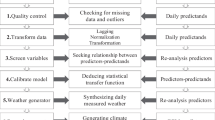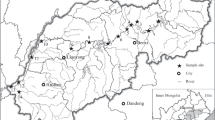Abstract
Reservoir operation of inter-basin water diversion project can effectively alleviate regional water shortage. However, future climate change will change regional runoff processes, which poses significant risks to the operation of inter-basin water diversion projects. The study considers occurrence probability of risk sources and risk-bearing bodies vulnerability, to constructs a risk operation system based on runoff forecast. Taking the inter-basin water diversion project from Hanjiang to Weihe River as a case, the study has made three contributions. Frist, the study uses the risk theory to derive the risk degree formula that consider multiple uncertain factors. Second, the difference in water diversion scale between risk operating and optimal operating is analyzed. The risk operating system can transfer the risk of water diversion from the dry period to the wet period, and reduce the probability of extreme risk. Third, the risk transfer law from water source area to water receiving area is quantified, and the influence law of risk source elements on risk degree is clarified. Risk source and risk bearing body in water receiving area are directly related to water shortage and its probability distribution. With the increase of water shortage probability, loss rate of socio-economic decreases. The research results have important application value for risk control of inter-basin water diversion projects and regional security of water supply.













Similar content being viewed by others
Data Availability
The dataset on which this paper is based is too large to be retained or publicly archived with available resources. Documentation and data used to support this study are available from hydrological station data.
References
Bacaksiz E, Opan M, Dilek ZEK et al (2023) Evaluation of optimal energy production using deterministic, probabilistic and risky cases in a multi-reservoir system. Water Resour Manage 37:5829–5848
Bai T, Li L, Huang Q (2021a) Risk operation of inhibiting salt tide invasion and its space-time transmission in Xijiang watershed. J Hydroelectr Eng 40(10):71–80
Bai T, Yu J, Wei J (2021b) Study on risk analysis of Sanhekou Reservoir operation based on different water demand processes. J Hydroelectr Eng 40(08):12–22
Bai T, Li L, Mu PF et al (2023) Impact of climate change on water transfer scale of inter-basin water diversion project. Water Resour Manage 37:2505–2525
Brown C, Ghile Y, Laverty M et al (2012) Decision scaling: Linking bottom-up vulnerability analysis with climate projections in the water sector. Water Resour Res 48(9):W09537
Chen HJ, Yang JP, Tan CP (2020) Estimating runoff variation in the future in a typical inland river based on the probability distribution method. J Glaciol Geocryol 42(04):1299–1307
Dong N, Wei J, Yang M et al (2022) Model estimates of China’s terrestrial water storage variation due to reservoir operation. Water Resour Res 58(6):e2021WR031787
Du XZ, Bai T, Ma X (2017) Study on water transfer mode of reservoir group within water-transferring region for Hanjiang-to-Weihe River Valley Water Diversion Project. Water Resour Hydropower Eng 48(08):2-7+136
El-Shafie A, El-Shafie AH, Mukhlisin M (2014) New approach: integrated risk-stochastic dynamic model for dam and reservoir optimization. Water Resour Manage 28(08):2093–2107
Fell R (1994) Landslide risk assessment and acceptable risk[J]. Can Geotech J 31:26l–272
Getachew T, Kim YO (2020) Representing inflow uncertainty for the development of monthly reservoir operations using genetic algorithms. J Hydrol 586:124876
He QS, Zhu YZ (2013) Studying of annual flow joint probability distribution based on high dimensions copula function. J Chongqing Univ Technol (Nat Sci) 27(08):112–120
He SK, Guo SL, Yang G et al (2020) Optimizing operation rules of cascade reservoirs for adapting climate change. Water Resour Manag 34(01):101–120
Hunt JD, Nascimento A, Caten CS et al (2022) Energy crisis in Brazil: Impact of hydropower reservoir level on the river flow. Energy 239A:121927
Immerzeel WW, Lutz AF, Andrade M et al (2020) Importance and vulnerability of the worlds water towers[J]. Nature 577(7790):364–369
Jin WT, Wang YM, Bai T et al (2019) Multi-objective operation and decision making of parallel reservoirs for Hanjiang-to-Weihe water diversion project in dry years. J Hydroelectr Eng 38(02):68–81
Kong B, Fu SJ, Huang Q (2020) Multi-objective optimal operation of hydropower plant-reservoir-pumping station group in large complex inter-basin water transfer projects. Water Resour Protect 36(06):67–72
Liang H, Huang SZ, Meng EH et al (2020) Runoff prediction based on multiple hybrid models. J Hydraul Eng 51(01):112–125
Liu B (2015) Overall layout of Hanjiang-to-Weihe river water diversion project. China Water Resour 14:76–79
Luo SX, Zhang ML, Nie YM et al (2022) Prediction of monthly precipitation in Zhengzhou based on CEEMDAN-LSTM model. Water Resour Plann Des 02:45–50
Qian LX, Wang HR, Dang SZ et al (2021) A coupled model for evaluating water shortage risk and its application. Syst Eng Theor Pract 41(05):1319–1327
Romano E, Guyennon N, Del Bon A, Petrangeli AB, Preziosi E (2017) Robust method to quantify the risk of shortage for water supply systems. J Hydrol Eng 22(8)
Tian Y, Zhao ZN, Huang HJ et al (2018) Study on water resources risk situation and risk prevention and control measures in China. China Water Resour 839(05):7–9+31
Wei D, Zhang C, Peng Y et al (2015) An analytical framework for flood water conservation considering forecast uncertainty and acceptable risk. Water Resour Res 51(06):4702–4726
Wu LZ, Bai T, Huang Q (2020) Tradeoff analysis between economic and ecological benefits of the inter basin water transfer project under changing environment and its operation rules. J Clean Prod 248:119294
Xu B, Huang X, Zhong PA et al (2020) Two-phase risk hedging rules for informing conservation of flood resources in reservoir operation considering inflow forecast uncertainty. Water Resour Manage 34:2731–2752
Yang Q, Qing L, Gao P et al (2021) Prediction of annual precipitation in the Northern Slope Economic Belt of Tianshan Mountains based on a EEMD-LSTM model. Arid Zone Res 38(05):1235–1243
Zhang JX, Wang GQ, Jin JL et al (2020) Evolution and variation characteristics of the recorded runoff for the major rivers in China during 1956–2018. Adv Water Sci 31(02):153–161
Zhang S, Kang Y, Gao X et al (2023) Optimal reservoir operation and risk analysis of agriculture water supply considering encounter uncertainty of precipitation in irrigation area and runoff from upstream. Agric Water Manag 277:108091
Zhao ZN, Tian Y, Zhang Y et al (2019) Analysis of connotation and current situation of water resources risks in China. Yellow River 41(01):46–50
Zhu BR, Ren YF, Lin JQ et al (2024) Multi-risk interaction analysis of cascade hydropower stations based on system dynamics simulation. Water Resour Manage 38:45–62
Funding
This study was supported by the National Natural Science Foundation of China (52179025, 51879213), the Natural Science Basic Research Plan in Shaanxi Province of China (2019JLM- 52, 2021JLM44), and the Planning Project of Science and Technology of Water Resources of Shaanxi Province (2022slkj-2).
Author information
Authors and Affiliations
Contributions
Linhui Mu: Term, Software, Resources, Writing—Original Draft, Visualization, Project administration, Funding acquisition. Tao Bai: Investigation, Data Curation, Writing—Review & Editing. Dong Liu: Validation, Formal analysis. Lei Li: Conceptualization, Supervision.
Corresponding author
Ethics declarations
Ethics Approval
There are no relevant waivers or approvals.
Consent to Participate
Authors consent to their participation in the entire review process.
Consent to Publication
Authors allow publication if the research is accepted.
Competing Interests
The authors declare that they have no known competing financial interests or personal relationships that could have appeared to influence the work reported in this paper.
Additional information
Publisher's Note
Springer Nature remains neutral with regard to jurisdictional claims in published maps and institutional affiliations.
Rights and permissions
Springer Nature or its licensor (e.g. a society or other partner) holds exclusive rights to this article under a publishing agreement with the author(s) or other rightsholder(s); author self-archiving of the accepted manuscript version of this article is solely governed by the terms of such publishing agreement and applicable law.
About this article
Cite this article
Mu, L., Bai, T., Liu, D. et al. Impact of Climate Change on Water Diversion Risk of Inter‑Basin Water Diversion Project. Water Resour Manage 38, 2731–2752 (2024). https://doi.org/10.1007/s11269-024-03777-0
Received:
Accepted:
Published:
Issue Date:
DOI: https://doi.org/10.1007/s11269-024-03777-0




